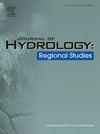Improving ecological water diversion process to promote oasis restoration using a monthly conceptual lumped ecohydrological model: A case study of the Qingtu Oasis, China
IF 4.7
2区 地球科学
Q1 WATER RESOURCES
引用次数: 0
Abstract
Study region
Qingtu Oasis, Shiyang River Basin, Northwest China.
Study focus
Improving the Ecological Water Diversion (EWD) process is crucial for promoting recovering terminal oases in arid inland basins. This research developed a Monthly Conceptual Lumped Ecohydrological Model (MCLEM) by integrating the surface water and groundwater balance, ecological response, and evapotranspiration equations. The MCLEM coupling with the scenario simulation effectively depicted the oasis’s intra-annual ecohydrological dynamics responding to various EWD processes under wet, regular, and dry meteorological conditions, implying for designing a rational EWD strategy achieving optimal ecological benefits regarding a larger oasis area and higher vegetation coverage.
New hydrological insights for the region
Given the total volume of 30 million m3, the current EWD of 10 million m3 each month during the second half of the vegetation growing season recovered the Qingtu Oasis to an average peak oasis area of 16.90 km2 and an average peak vegetation coverage of 15.90 % under various meteorological conditions. Comparatively, the EWD of 5 million m3 each month during the entire vegetation growing season could produce an average peak oasis area of 20.17 km2 and an average peak vegetation coverage of 18.59 %. Comparing the ecological benefits resulting from different EWD scenarios suggested adjusting the EWD process from transferring water during the second half of the vegetation growing season to transferring water during the entire vegetation growing season.
求助全文
约1分钟内获得全文
求助全文
来源期刊

Journal of Hydrology-Regional Studies
Earth and Planetary Sciences-Earth and Planetary Sciences (miscellaneous)
CiteScore
6.70
自引率
8.50%
发文量
284
审稿时长
60 days
期刊介绍:
Journal of Hydrology: Regional Studies publishes original research papers enhancing the science of hydrology and aiming at region-specific problems, past and future conditions, analysis, review and solutions. The journal particularly welcomes research papers that deliver new insights into region-specific hydrological processes and responses to changing conditions, as well as contributions that incorporate interdisciplinarity and translational science.
 求助内容:
求助内容: 应助结果提醒方式:
应助结果提醒方式:


